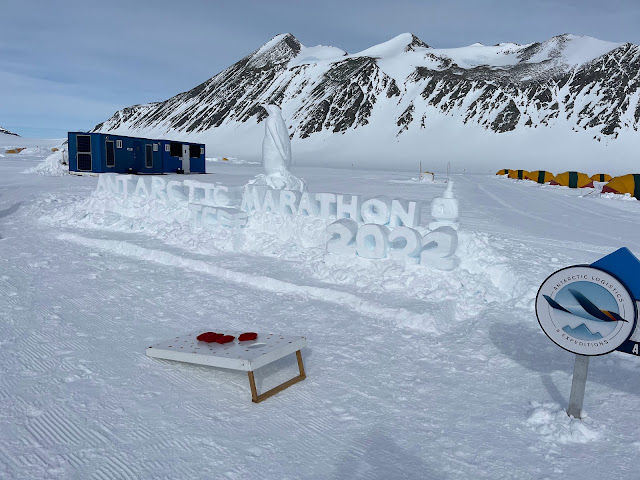5:22 finish, 22/57 place overall. One of only two marathons in Antarctica within the Antarctic Circle, this race runs four laps of about 6.5 miles starting and finishing at the Union Glacier camp, a few hundred miles from the South Pole. The entire course is on a snow covered glacier, making the terrain difficult to run on and producing much slower than normal finish times. It’s more comparable to running on sand or uneven trails than on roads. Luckily this year’s temperatures were relatively mild (teens Fahrenheit) with not much wind, so while much harder than a normal road marathon, it could have been even more challenging. Third slowest finish time ever (after Pikes Peak in 2011 and Zermatt, Switzerland in 2017) but not unexpected considering the difficulty of the course. Outstanding scenery of course, and overall great experience with a friendly group of crazy runners from all over the world. Nice to finally be done with the seven continents.
More race info and photos...
For this race runners are required to arrive in Punta Arenas, Chile, three days before scheduled departure to Antarctica for a race briefing, cold weather clothing check, Covid testing, and luggage preparation. These are a few pictures from around Punta Arenas before and after the marathon…
From Punta Arenas, it's about a four-hour flight to Union Glacier, Antarctica on a B-757 jet chartered by the logistics company that operates the trip. This year the plane left Punta Arenas a day late due to unsafe flying weather at Union Glacier. Flight delays to and from Antarctica are very common because if it's too cloudy or foggy, pilots cannot safely land on the ice runway. This is from the plane going into Antarctica...
This is the plane after landing on the ice runway and the transport vehicles that shuttle visitors to the camp a few miles away…
Union Glacier camp houses visitors for all different activities (not just the marathon) during the summer period of November through January. Marathoners spend two nights there, one before and one after race day…
A closer view of the sleeping tents, which are naturally heated by the 24 hours of daylight in summer… Heavy sleeping bags are provided on cots with air mattresses…
Inside the main dining and cooking tent, which is where meals and snacks are served and where people spend much of their down time…
The marathon start/finish line before the race started… There was some light snow and fog at the start, but very little wind and “mild” temperatures in the teens…
The lack of extreme cold and wind made the race somewhat easier, but recent snowfall - including during the race - made the surface conditions tougher to run on than in previous years when the snow was more packed down. The snow ended mid-race and the clouds cleared for some better scenery in the later miles…


















